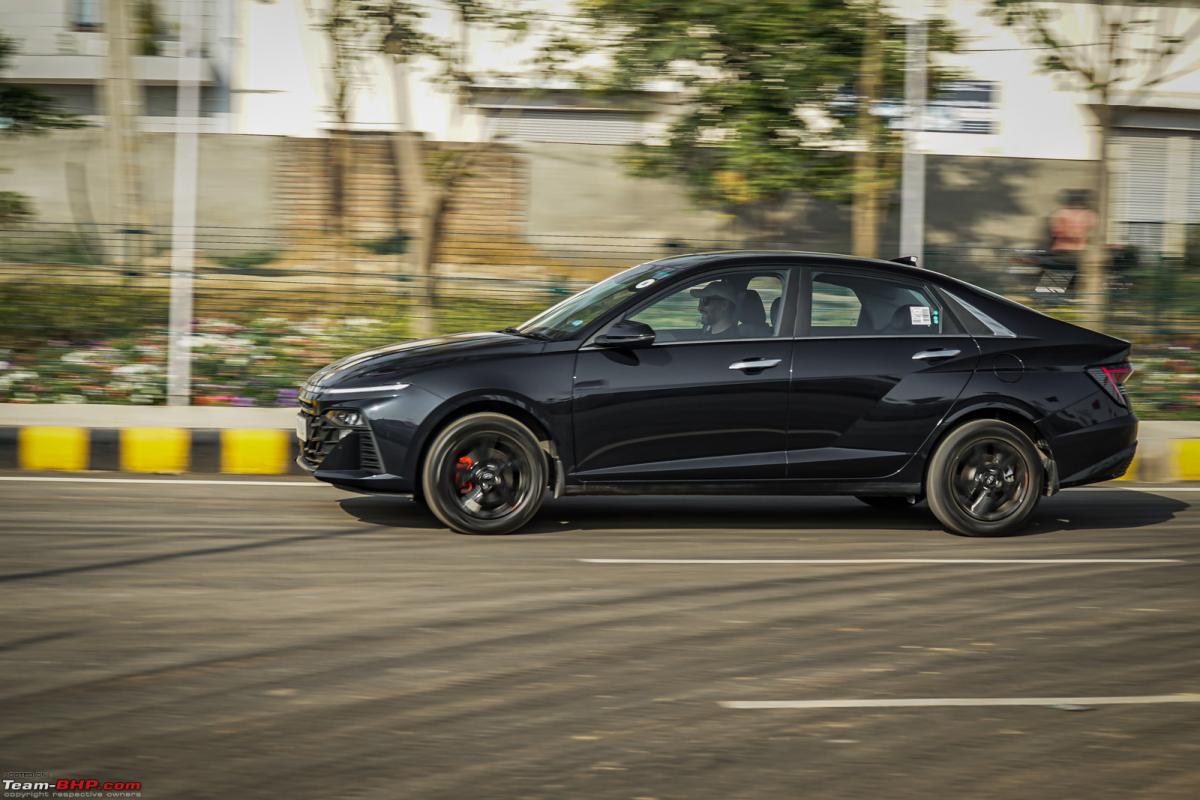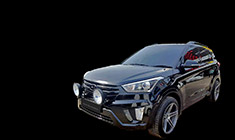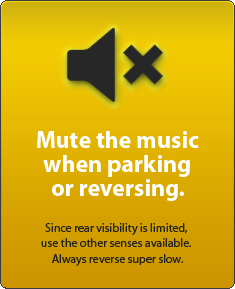News
Hyundai Verna : Our observations after a day of driving
Fire up the engine, and it's refined like a typical Hyundai, silently purring away. Hyundai powertrains have always set NVH benchmarks, and this car is no different.
Driving the Hyundai Verna 1.5L Turbo-Petrol DCT Automatic
1.5L, 4-cylinder turbo-petrol engine makes 158 BHP @ 6,300 rpm and 253 Nm @ 1,500-3,500 rpm:

The previous generation Verna came with a 118 BHP, 1.0-litre turbo petrol engine that didn't find a lot of buyers. This time around, since the Volkswagen - Skoda twins have powerful turbo-petrols, Hyundai decided to plonk a bigger engine in the Verna. The 138 BHP, 1.4-litre Kappa turbo-petrol engine from the Creta made perfect sense, but that had to be upgraded to meet the emission norms. The result is this Smartstream 1.5-litre turbo-petrol engine which still belongs to the Kappa family and makes an impressive 158 BHP and 253 Nm. These are the highest numbers in the segment, which should indicate that the Verna is F-A-S-T.
Fire up the engine, and it's refined like a typical Hyundai, silently purring away. Hyundai powertrains have always set NVH benchmarks, and this car is no different. Shift to D or R, and it crawls away smoothly. Crawling at city speeds isn’t very dramatic and the 1.5L is very well-behaved. With light to medium throttle inputs, you can go about your daily commute quite comfortably. In comparison with the old 1.4L turbo-petrol in the Creta, the throttle response is smoother and power delivery is more linear. The 7-speed dual-clutch transmission is also pretty seamless moving through the initial gears. However, we did notice that the gearbox got a little confused on a few instances while driving through some traffic. The engine has a healthy bottom end and thanks to a turbocharger and direct injection, you’re never in a shortage of power. Just floor the accelerator if you want to close a gap in traffic or make that quick overtake and the engine and gearbox will do the rest.
Get on some open roads and you can let the Verna stretch its legs. Put down your right foot and before you know it, you’ll hit the highway speed limit of 120 km/h. This is the thing with turbo-petrols - flooring the throttle on an empty stretch of road can get pretty addictive. Outright acceleration is great and it feels a little more linear as well compared to say, the 1.5 TSI from the VW-Skoda cars. The turbo delivers a strong mid-range punch that will take care of all the overtaking on the highway. You can cruise along the highway at 100 km/h while the engine spins at a relaxed 1,800 rpm. Even at 120 km/h on the Delhi-Mumbai expressway, the engine felt relaxed with the rev counter reading 2,200 rpm. The Verna won't break a sweat cruising at these speeds all day long.
The dual-clutch transmission moves through the gears quite seamlessly. The kickdown response time is quick enough and the gearbox doesn’t hesitate to drop down 3 or even 4 gears at times to get the engine into the powerband. When you are in the mood for some fun in the ghats, switch to Sport mode and start flipping the paddle shifters for manual control. The ECU matches the revs and you’ll hear the sweet note of the engine. Yes, IMO, the engine sounds nice and sporty at high revs. Although Hyundai has restricted the maximum rpm to 5,900, which is too low, at least the engine sounds great as it reaches that number. The paddle shifters are pretty responsive and you can extract some performance from the engine using them for quick overtakes or keeping the engine in the powerband over some twisties. There is no "S" mode for the gearbox and pushing the car while in Sport mode, you will find that you cannot rely on the gearbox alone to go fast. You have to take control of the gears using the paddle shifters and manually keep the engine in the power band. I wouldn’t say the same about the DSG in VW-Skoda cars. The gearbox logic in the Slavia and Virtus 1.5 DSG is way better and more in tune with the requirements of the driver.
The Verna gets 3 drive modes - Eco, Normal and Sport.
Eco Mode - Engage the Eco mode when you want to extract maximum fuel efficiency. The throttle response is dulled, but given the power on tap, the mode is quite comfortable to use in the city. In fact, we preferred driving in this mode in the city as the car becomes a lot smoother to drive. The Auto Start-Stop feature is activated automatically when you select the Eco mode.
Normal Mode - This is the default mode and just as the name suggests, it's pretty normal to drive. The difference between Normal and Eco modes is very little.
Sport Mode - Engage this mode when you want the car to be more responsive to your inputs. The throttle response is sharper and the transmission also holds on to gears a bit longer in this mode. The steering is also noticeably heavier, although not as much as enthusiasts would like (more on this later). The Sport mode isn't something you'd want to engage in the city as it can get a bit jerky to drive.
Noise, Vibration & Harshness (NVH)
The 1.5-litre unit is very refined overall. At city speeds as well as while cruising at 100 km/h, you can barely hear the engine in the cabin. Even the vibrations are well controlled and cruising with the family on the highway should be pretty comfortable. Road noise from the tyres does creep into the cabin at highway speeds, but the wind noise is kept well in check. The engine has a sporty note to it at high revs.
Mileage & Fuel economy
The Verna comes equipped with an Auto Start-Stop feature that helps fuel efficiency in city driving conditions. The ARAI certified fuel efficiency for the 1.5-litre turbo-petrol DCT is a whopping 20.6 km/l and that for the 6-speed MT is 20 km/l. Of course, the real-world FE numbers will be much lower considering that turbo-petrol DCTs are very sensitive to the driving style. We’ll wait for some ownership reviews to get a better picture of real-world fuel efficiency.
Suspension

Ride Comfort
The Verna gets a McPherson strut suspension at the front and a torsion beam axle at the rear. Higher variants are equipped with 16-inch alloy wheels shod with 205/55 section tyres. Like most Hyundais, the Verna is tuned for comfort and has an absorbent ride. The slow speed ride is comfortable and will be appreciated by most people. The suspension also works very silently in absorbing small bumps and potholes. Big potholes do register themselves in the cabin. There’s some body movement felt in the cabin over bad roads, but it doesn't get very uncomfortable.
Handling & Dynamics
The previous generation Verna and some of the older Hyundais were notorious for feeling floaty at high speeds. The new Verna has improved in this regard to an extent. At high speeds, the car is stable and feels very steady cruising at 100-120 km/h. That said, there’s still a bit of vertical movement at high speeds while going over bumps and expansion joints - it takes a couple of bobs before settling down.
When we talk about the dynamics of the car, understand that the Verna is softly sprung. This doesn’t really translate to good handling characteristics and is a stark contrast to the sporty nature of the engine. Get to a corner and the turn in is sharp as the heavy front end keeps the nose planted. You can guide the car into the corner well, but then, you are met with a good amount of body roll. Carry some extra speed and you will encounter some understeer as well. Change directions from one corner to another quickly and you can actually feel the whole weight transfer happening behind you. Under most driving conditions on roads, the car will hold its line well. However, the chassis doesn’t really complement the powerful engine and enthusiasts will be looking for some stiffer springs as their first upgrade. In comparison, the Skoda Slavia and Volkswagen Virtus despite being less powerful, offer a lot more for enthusiasts when it comes to handling and dynamics.

Steering
The EPS is light and user-friendly at parking and city speeds. It’s something you would expect from a Hyundai. For driving around in the city and occasional highway trips, this steering is just perfect. It weighs up adequately on the highways and there’s little vagueness in the centre. However, from an enthusiast's perspective, there’s nothing on offer. It feels very disconnected and light even at high speeds and in Sport mode.
Braking
Only the top turbo-petrol variant with the DCT gets all-wheel disc brakes. All other variants, including the turbo-petrol manual, get drum brakes at the rear. The stopping power from the all-wheel disc brake setup is good and we didn’t find any issues during our test drive. The pedal also feels good to use and has a progressive feel to it.
Niggles & Problems
Hyundai isn’t a company you associate with poor reliability and bad after-sales. However, while most of the recent feedback has been positive, the turbo-petrol engine with the dual-clutch transmission is something you should be careful with. Early owners of the Creta & Seltos 1.4 turbo-petrol DCT did face some gearbox overheating issues. While most of them have been resolved, it’s very much advisable to go for the maximum extended warranty of 7 years. Don’t even think about it twice, it’s better to be safe than sorry.
Continue reading the discussion on the Hyundai Verna on our forum.


















